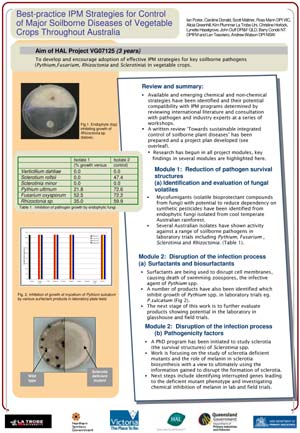|
The aim of HAL project VG07125 is to develop and encourage adoption of effective IPM strategies for key soilborne pathogens (Pythium, Fusarium, Rhizoctonia and Sclerotinia) in vegetable crops.
Available and emerging chemical and non-chemical strategies have been identified and their potential compatibility with IPM programs determined by reviewing international literature and consultation with pathogen and industry experts at a series of workshops.
Authors
|
|
Ian Porter
|
Caroline Donald
|
|
Scott Mattner
|
Ross Mann
|
|
Alicia Greenhill
|
Lynette Haselgrove
|
|
Christine Horlock
|
Kim Plummer
|
|
Barry Condè
|
John Duff
|
|
Andrew Watson
|
Len Tesoriero
|


Progress report :
- Reduction of pathogen survival structures
- Mycofumigants with potential to reduce dependency on synthetic pesticides have been identified from endophytic fungi isolated from cool temperate Australian rainforest.
- Several Australian isolates have shown activity against a range of soilborne pathogens in laboratory trials including Pythium, Fusarium , Sclerotinia and Rhizoctonia.
- Disruption of the infection process by surfactants
- Surfactants are being used to disrupt cell membranes, causing death of swimming zoospores, the infective agent of Pythium spp.
- A number of products have also been identified which inhibit growth of Pythium spp. in laboratory trials.
- The next stage of this work is to further evaluate products showing potential in the laboratory in glasshouse and field trials.
- Disruption of the infection process – Pathogenicity factors
- A PhD program has been initiated to study sclerotia (the survival structures) of Sclerotinia spp.
- Work is focusing on the study of sclerotia deficient mutants and the role of melanin in sclerotia biosynthesis with a view to ultimately using the information gained to disrupt the formation of sclerotia.
- Next steps include identifying interrupted genes leading to the deficient mutant phenotype and investigating chemical inhibition of melanin in lab and field trials.
Acknowledgments :
Funding was provided by Australian vegetable growers (through the R & D levy) and the Department of Primary Industries, Victoria. The Australian Government provides matched funding for all HAL’s R&D activities.
|

